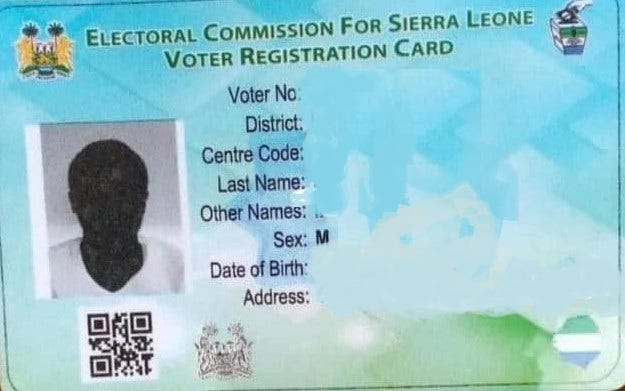Decoding the Trend: Why Sierra Leone’s Voter ID Cards Have Black and White Photos?
By: Samson Rahman

As the electoral season approaches in Sierra Leone, citizens have been receiving their voter identification cards with a surprising feature — black and white photos. This departure from the traditional colour photos has raised questions and concerns among the electorate: With advancements in technology, why would the Electoral Commission for Sierra Leone (ECSL) choose to print Voter ID cards in black and white, a seemingly regressive step in the era of high-resolution color printing?
In this article, I will explore the reasons behind this shift and uncover the security advantages of the black-and-white photos on voter ID cards.
Governments around the world, including Greece (where the Voter ID Cards were printed), have been adopting the use of black and white or grayscale photos in their identification documents, such as passports and national ID cards. This trend, which is a novel approach to passport and ID cards, has gained popularity in Europe, Asia, and even the United States. For instance, driving licenses in New York, ID cards in Singapore, and passports in Cambodia all feature black and white photos. This begs the question — why the shift towards black and white?
One key reason is the increasing use of polycarbonate as the material of choice for ID documents. Polycarbonate is a durable and secure material that offers significant advantages over traditional Polyvinyl Chloride (PVC) or paper-based documents. Unlike other card materials that are added in layers, polycarbonate fuses together to create a single card body, making it resistant to delamination. This durability ensures that the ID cards have a longer lifespan, typically exceeding 10 years.
Another factor is the security features that can be incorporated into polycarbonate cards. The optimal method to personalize polycarbonate cards is through fibre laser engraving, which is irreversible and cannot be easily tampered with. Additionally, polycarbonate cards can be perforated with tiny holes to create a secondary image that is visible when held up to a light source, similar to a watermark. These security features make it extremely difficult for fraudsters to reproduce or alter the Voter ID cards.
The use of black and white photos on the voter ID cards also serves a security purpose. Black and white photos are better for checking purposes as they do not distract by skin colour tones, according to an immigration officer. Additionally, the use of invisible ink that only appears under UV light and QR codes further enhances the security of the ID cards, making it challenging to mass-produce counterfeit cards.
The Electoral Commission for Sierra Leone (ECSL) must be commended for the thoughtful inclusion of these security features on the voter ID cards. The self-laminated cards with holographic coat of arms, invisible ink, and QR codes are a significant step towards preventing fraud and ensuring the integrity of the electoral process. The use of black and white photos on the cards is a deliberate choice in line with the global trend of using polycarbonate cards and enhancing security features.
Despite the advantages of using black and white photos for security reasons, there have been concerns raised about mismatched details, missing photos, and incorrect sex and residential details on some voter ID cards. It is important for the Electoral Commission for Sierra Leone (ECSL) and other Electoral Management Bodies (EMBs) to address these discrepancies and ensure that all citizens have accurate and reliable identification for exercising their democratic right to vote.
The Million Dollar Question: Why the Faces on the Voter ID Cards are Not Visible in Black and White Printing?
One of the main reasons why faces on the Voter ID cards may not be visible when printed in black and white is the printing resolution. Printing resolution refers to the number of dots per inch (dpi) that a printer can produce (https://en.wikipedia.org/wiki/Dots_per_inch). Higher dpi results in more detailed and sharper images, while lower dpi can result in blurry or pixelated images.
ID card printers are typically designed to produce high-resolution images to ensure the security and authenticity of the cards. These printers use advanced printing technologies that can print images with a resolution of 300 dpi or higher, which is much higher than the resolution of standard home printers. The high resolution is necessary to print small text, intricate designs, and security features, such as barcodes and holograms, which are commonly found on ID cards.
However, when printing in black and white, the printer uses only one colour, typically black, to create the entire image. This means that the printer has to reproduce all the shades of gray, from pure white to pure black, using just one colour. This can be challenging for the printer, as it must create a smooth transition from light to dark areas using only black ink. As a result, the details of the image, such as facial features, may not be as clearly visible in black-and-white printing compared to colour printing.
Additionally, the faces on the Voter ID cards are small in size, and the printing resolution may not be sufficient to capture all the details of a face in black and white. Even with high-resolution printing, some fine facial features, such as small lines, shadows, and contours, may not be as prominent in black-and-white printing as they would be in colour printing.
It’s also worth noting that the Voter ID cards are printed on plastic or laminated materials, which further affected the clarity of the printed images. Plastic surfaces can reflect light differently compared to paper, and this can impact the visibility of facial features when printed in black and white.
Despite these limitations, the Photos on some Voter ID cards printed in black and white can still serve their intended purpose of establishing the identity of an individual, as other information, such as the name, date of birth, and ID number, can still be clearly visible.




